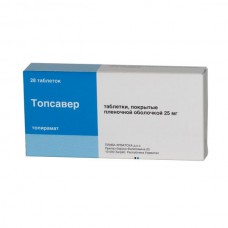Expiration date: 01/2025
Structure and Composition:
Tablets, film-coated. One tablet contains active substance:
Topiramate 25 mg
Excipients: lactose monohydrate - 23 mg pregelatinized starch - 7.2 mg pregelatinized starch, partly - 0.8 mg MCC - 20.8 mg Sodium carboxymethyl starch - 2.4 mg Magnesium stearate - 0.8 mg
shell: hypromellose - 1,272 mg of polysorbate 80 - 0.06 mg talc - 0.78 mg titanium dioxide (E171) - 0,288 mg
Topiramate 100 mg
Excipients: lactose monohydrate - 92 mg pregelatinized starch - 28.8 mg of pregelatinized starch, partly - 3.2 mg MCC - 83.2 mg Sodium carboxymethyl starch - 9.6 mg Magnesium stearate - 3.2 mg
shell: hypromellose - 5.088 mg of polysorbate 80 - 0.24 mg of talc - 3.12 mg titanium dioxide (E171) - 0.922 mg of yellow iron oxide (E172) - 0.23 mg
in blister oriented polyamide / aluminum foil / PVC / aluminum foil 14 pcs. In the paper cartons 2 blisters.
Description pharmaceutical form:
Tablets 25 mg: white, round, biconvex, film-coated, marked with "TO" on one side and "25" on the other.
Tablets 100 mg: yellow, round, biconvex, film-coated, marked with "TO" on one side and "100" on the other.
Pharmacokinetics:
Topiramate is rapidly and well absorbed. Food intake has no clinically significant effect on its bioavailability, which is about 80%. Connection with the plasma protein-13-17%. Middle Vd - 0,55-0,8 l / kg for single doses up to 1200 mg. This figure depends on gender: women, these values ??constitute 50% of the values ??observed in men, which is associated with higher levels of fat tissue in women. Metabolized about 20% of topiramate. Up to 50% of topiramate is metabolized in patients concurrently taking other anti-epileptic drugs (AEDs) that induce metabolizing enzymes. From the plasma, urine and feces identified six human practically inactive metabolites topiramate. Unchanged topiramate and its metabolites are mainly excreted through the kidneys. Plasma clearance of about 20-30 ml / min. After a single dose is linear pharmacokinetics, plasma clearance is constant, and the area under the curve "concentration-time" in doses ranging from 100 to 400 mg increases proportionally with dose. During normal renal patients may require 4-8 days to reach equilibrium plasma concentrations. The mean Cmax value after repeated oral administration of 100 mg twice a day topiramate is 6.76 g / ml. T1 / 2 After multiple administration of 50 and 100 mg twice a day is 21 hours.
In patients with renal impairment (Cl creatinine <60 p = "">
The pharmacokinetics of topiramate in children, as in adults, is linear. Clearance does not depend on the drug dose, the equilibrium concentration in the plasma increases proportionally with dose. However, children have higher clearance values ??and a shorter T1 / 2. Consequently, the concentration of topiramate in plasma when receiving the same dose per 1 kg of body weight can be lower for children compared with adults.
Topiramate is effectively cleared from the blood plasma by hemodialysis.
Presumably it passes into breast milk.
Description of the pharmacological actions:
Topiramate belongs to sulfatzameschennym monosaccharides. Does sodium channels and suppresses the occurrence of repetitive action potentials on a background of prolonged depolarization of the membrane of the neuron. It increases GABA activity in respect of certain subtypes of GABA receptors. Inhibits activation sensitivity kainate subtype kainate / AMPA alpha-amino-3-hydroxy-5-methylisoxazole-4-propionic acid) receptors to glutamate, without affecting the activity of N-Metil-D-acpaptata (NMDA) against NMDA-receptors. These effects are dose-dependent. Additionally, topiramate inhibits some isozymes of carbonic anhydrase. This effect is much weaker than that of acetazolamide, a carbonic anhydrase inhibitor, and is not a major component of the antiepileptic activity of topiramate.
Indications:
- monotherapy of epilepsy in children of 7 years and adults (including in patients with newly installed epilepsy)
- adjuvant therapy in children from 3 years and adults with lack of effectiveness of AEDs first choice for partial or generalized tonic-clonic seizures, as well as seizures in the background Lennox-Gastaut syndrome.
Contraindications:
- hypersensitivity to any component of the drug
- Children under 3 years
- pregnancy and lactation.
Precautions: renal or hepatic impairment, nefrourolitiaz (including history, including family), hypercalciuria.
Side effect:
Neurological and psychiatric disorders: anxiety, dizziness, headache, disturbances of speech and vision, psychomotor retardation, ataxia, fatigue, difficulty concentrating, confusion, paresthesia, drowsiness, abnormal thinking, diplopia, anorexia, nystagmus, depression, perversion of taste sensations , agitation, cognitive impairment, emotional lability, apathy, psychotic symptoms, aggressive behavior, suicidal ideation or attempts to further children - personality disorder, increased salivation, hyperkinesia, hallucinations.
Gastrointestinal disorders: dyspepsia, nausea, abdominal pain, diarrhea, dry mouth, increased liver enzymes, hepatitis, liver failure.
On the part of the eye: may cause myopia syndrome accompanied by increased intraocular pressure, a sharp decline in visual acuity and pain in the eyes. Myopia, reducing the depth of the anterior chamber of the eye, eye redness of the mucous membrane and increased intraocular pressure, mydriasis. A possible mechanism is an increase in data breaches supratsiliarnogo effusion that leads to a shift forward of the lens and iris, and as a consequence - the development of secondary angle-closure glaucoma.
Skin and mucous membranes: erythema multiforme, pemphigus, Stevens-Johnson syndrome and toxic epidermal necrolysis.
Other: weight loss, leukopenia, nephrolithiasis, oligogidroz (mainly in children), metabolic acidosis.
Drug Interactions:
Effect of topiramate on other AEDs
It does not affect the concentration of carbamazepine, valproic acid, phenobarbital, primidone. In some cases, when using phenytoin, phenytoin may increase the plasma concentration.
Effect of topiramate on other AEDs
In a joint application of topiramate to phenytoin and carbamazepine may decrease plasma concentrations of topiramate, thus with the addition or withdrawal of phenytoin or carbamazepine is recommended that dose adjustment of topiramate.
When taking other AEDs inducing liver enzymes topiramate reduced maximum concentration in plasma.
Other interactions
Digoxin: reduced by 12% the AUC of digoxin.
Oral Contraceptives: topiramate at a dose of 50-800 mg / day has no significant effect on efficacy and norethindrone in a dose of 50-200 mg / day - the efficiency of ethinyl estradiol. Significant dose-dependent decrease in efficiency was observed when receiving ethinylestradiol topiramate at a dose of 200-800 mg / day. Patients taking oral contraceptives should tell your doctor about any changes in bleeding patterns.
Metformin: while the use of topiramate the mean Cmax and AUC of metformin increased by 18 and 25%, respectively, while the mean total clearance is reduced by 20%. Topiramate does not affect the Tmax of metformin. Plasma clearance of topiramate is reduced under the influence of metformin. The clinical significance of effects of metformin on the pharmacokinetics of topiramate is unclear. The appointment or termination of topiramate on metformin therapy is necessary to monitor the status of carbohydrate metabolism.
Hydrochlorothiazide: while admission is an increase in Cmax of topiramate by 27% and AUC by 29% of topiramate.
CNS depressants: not recommended with topiramate simultaneous reception of ethanol and other means, oppressive central nervous system.
Pioglitazone: it revealed a decrease in AUC of pioglitazone by 15%, without changing the Cmax of the drug. For active gidroksimetabolita pioglitazone showed a reduction in the Cmax and AUC by 13 and 16%, respectively, and for the active ketometabolita - reduction and Cmax, and AUC by 60%. The clinical significance of these data is unknown.
Other facilities: topiramate when used in conjunction with other agents predisposing to nephrolithiasis, in particular carbonic anhydrase inhibitors (acetazolamide), may increase the risk of nephrolithiasis. During use of topiramate patients should avoid taking such drugs, as they can establish the physiological conditions that increase the risk of formation of kidney stones.
Dosage and administration:
Inside, swallowing the tablet whole without chewing, regardless of the meal. For optimal control of seizures, it is recommended to start treatment with low doses with a subsequent increase to the effective dose.
In the combined therapy
Adults: the minimum effective dose - 200 mg / day. The usual daily dose - 200-400 mg (2 receptions). The maximum daily dose - 1600 mg. Treatment starts with 25-50 mg daily at night for 1 week. the dose was then increased to 25-50 mg per day for 1-2 weeks, with a multiplicity of receiving two times a day. At intolerance of such a dosing regimen the dose is increased by a smaller amount, or increase the interval between doses. The dose and dosing frequency is selected depending on the clinical effect.
Children older than 3 years: The recommended daily dose is 5-9 mg / kg divided into 2 doses. Treatment is initiated with a dose of 25 mg at night for 1 week. Thereafter, the dosage is increased by 1.3 mg / kg / day for 1-2 weeks, with a multiplicity of receiving two times a day, to achieve optimal clinical effect.
Monotherapy
Adults: treatment begins with 25 mg at night for 1 week. the dose was then increased to 25-50 mg per day for 1-2 weeks, with a multiplicity of receiving two times a day. At intolerance of such a dosing regimen, the dose is increased by a smaller amount, or increase the interval mzhdu techniques. The dose and dosing frequency is selected depending on the clinical effect. The recommended starting dose of topiramate monotherapy in adults with newly diagnosed epilepsy is 100 mg / day with a maximum recommended dose - 500 mg / day. These doses are recommended for all adults, including the elderly with normal renal function.
Children aged 7: treatment starts with a dose of 0.5-1 mg / kg per night for 1 week. Thereafter, the dosage is increased by 0.5-1 mg / kg / day for 1-2 weeks, the multiplicity of reception - 2 times a day. At intolerance of such a dosing regimen the dose is increased by a smaller amount, or increase the interval between doses. The dose and dosing frequency is selected depending on the clinical effect. The recommended dose range - 3.6 mg / kg. Children with recently established partial seizures can be assigned up to 500 mg / day.
Overdose:
Symptoms: convulsions, disturbance of consciousness up to coma, decreased blood pressure, severe metabolic acidosis, increased severity of side effects.
Treatment: gastric lavage, activated charcoal, symptomatic therapy, hemodialysis.
Special instructions:
When receiving the drug for women is recommended to use adequate contraception.
Topiramate, as well as other AEDs, it is recommended to cancel, gradually reducing the dose, in order to reduce the potential risk of increased frequency of seizures.
Renal impairment: Patients with moderate and severe strongly impaired renal function may need 10-15 days to reach equilibrium concentration in plasma as opposed to 4-8 days in patients with normal renal function. As with all patients, a gradual increase in dose should be administered in accordance with clinical outcomes (such as the control of seizures, frequency of side effects), given that patients with moderate or severe renal impairment may require a longer time to reach steady-state after each dose.
Nephrolithiasis: Some patients, especially those predisposed to nephrolithiasis, may increase the risk of forming kidney stones, accompanied by symptoms such as renal colic, pain in the side and in the kidney area. It is recommended that adequate hydration to reduce the risk of kidney stones.
Hepatic impairment: in patients with impaired liver function topiramate clearance is reduced.
Myopia and secondary angle-closure glaucoma: the development of myopia topiramate should be repealed as soon as clinically possible, and to take measures to reduce intraocular pressure.
Metabolic acidosis: the application of topiramate may hyperchloraemic not associated with a deficit of anions, metabolic acidosis (eg, reduced plasma concentrations of hydrocarbons below normal levels in the absence of respiratory alkalosis). This reduction in the concentration of hydrocarbons serum is a consequence of the inhibitory effect of topiramate on renal carbonic anhydrase. In this connection, in the treatment of topiramate to periodically determine the concentration of hydrocarbons in the serum.
Diet: When reducing weight during therapy topiramate is useful to consider the possibility of appointing additional power.
During treatment advised to refrain from driving and work that require high concentration and speed of psychomotor reactions.



